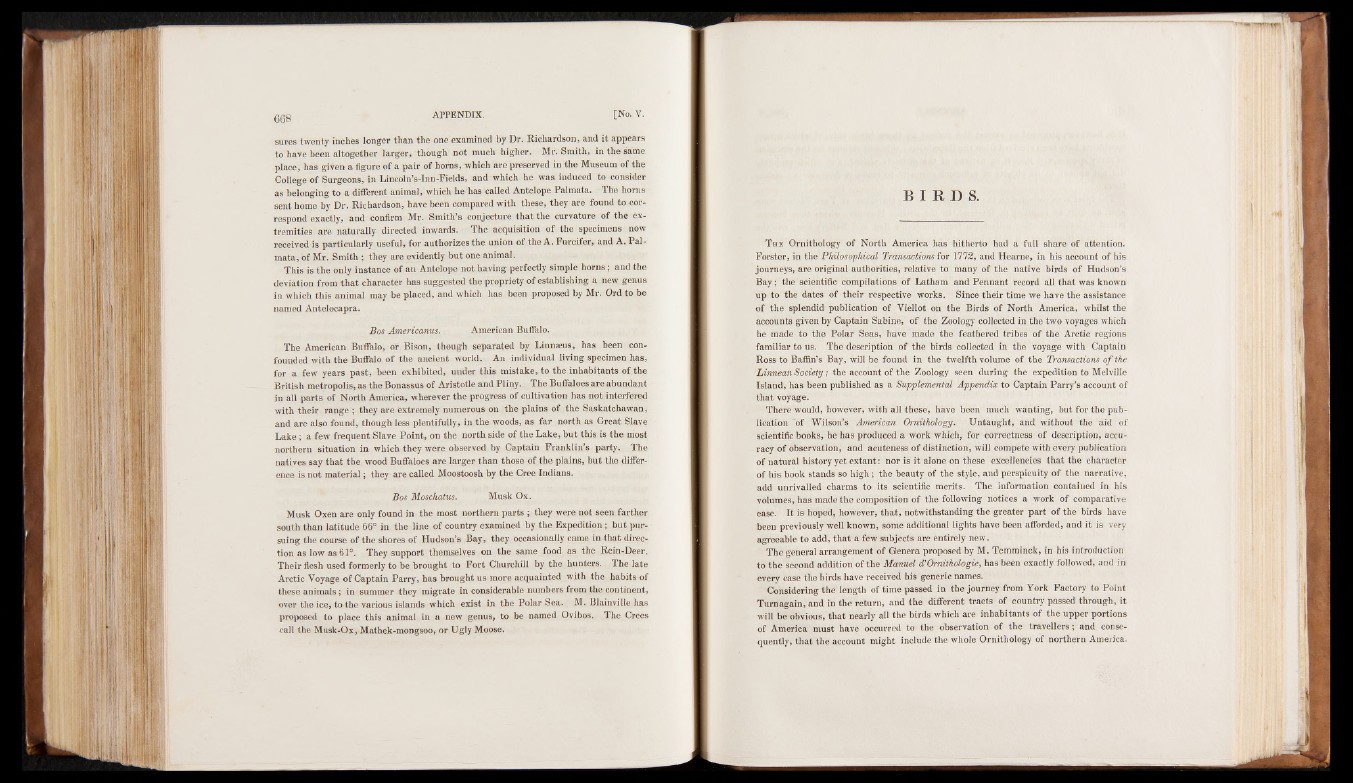
sures twenty inches longer than the one examined by Dr. Richardson, and it appears
to have been altogether larger, though not much higher. Mr. Smith, in the same
place, has given a figure of a pair of horns, which are preserved in the Museum of the
College of Surgeons, in Lincoln’s-Inn-Fields, and which he was induced to consider
as belonging to a different animal, which he has called Antelope Palmata. The horns
sent home by Dr. Richardson, have been compared with these, they are found to correspond
exactly, and confirm Mr. Smith’s conjecture that the curvature of the extremities
are naturally directed inwards. The acquisition of the specimens now
received is particularly useful, for authorizes the union of the A. Furcifer, and A. Palmata,
of Mr. Smith ; they are evidently but one animal.
This is the only instance of an Antelope not having perfectly simple horns; and the
deviation from that character has suggested the propriety of establishing a new genus
in which this animal may be placed, and which has been proposed by Mr. Ord to be
named Antelocapra.
Bos Americanus. American Buffalo.
The American Buffalo, or Bison, though separated by Linnaeus, has been confounded
with the Buffalo of the ancient world. An individual living specimen has,
for a few years past, been exhibited, under this mistake, to the inhabitants of the
British metropolis, as the Bonassus of Aristotle and Pliny. The Buffaloes are abundant
in all parts of North America, wherever the progress of cultivation has not interfered
with their range ; they are extremely numerous on the plains of the.Saskatchawan,
and are also found, though less plentifully, in the woods, as far north as Great Slave
Lake; a few frequent Slave Point, on the north side of the Lake, but this is the most
northern situation in which they were_observed by Captain Franklin’s party. The
natives say that the wood Buffaloes are larger than those of the plains, but the difference
is not material; they are called Moostoosh by the Cree Indians.
Bos Moschatus. Musk Ox.
Musk Oxen are only found in the most northern parts ; they were not seen farther
south than latitude 66° in the line of country examined by the Expedition; but pursuing
the course of the shores of Hudson’s Bay, they occasionally came in that direction
as low as 61°. They support themselves on the same food as the Rein-Deer.
Their flesh used formerly to be brought to Fort Churchill by the hunters. The late
Arctic Voyage of Captain Parry, has brought us more acquainted with the habits of
these animals; in summer they migrate in considerable numbers from the continent,
over the ice, to the various islands which exist in the Polar Sea.. M. Blainville has
proposed to place this animal in a new genus, to be named Ovibos. The Crees
call the Musk-Ox, Mathek-mongsoo, or Ugly Moose.
B I R D S .
The Ornithology of North America has hitherto had a full share of attention.
Forster, in the Philosophical Transactions for 1772, and Hearne, in his account of his
journeys, are original authorities, relative to many of the native birds of Hudson’s
Bay ; the scientific compilations of Latham and Pennant record all that was known
up to the dates of their respective works. Since their time we have the assistance
of the splendid publication of Yiellot on the Birds of North America, whilst the
accounts given by Captain Sabine, of the Zoology collected in the two voyages which
he made to the Polar Seas, have made the feathered tribes of the Arctic regions
familiar to us. The description of the birds collected in the voyage with Captain
Ross to Baffin’s Bay, will be found in the twelfth volume of the Transactions of the
Linnean Society ; the account of the Zoology seen during the expedition to Melville
Island, has been published as a Supplemental Appendix to Captain Parry’s account of
that voyage.
There would, however, with all these, have been much wanting, but for the publication
'of Wilson’s American Ornithology. Untaught, and without the aid of
scientific books, he has produced a work which, for correctness of description, accuracy
of observation, and acuteness of distinction, will compete with every publication
of natural history yet extant : nor is it alone on these excellencies that the character
of his book stands so high ; the beauty of the style, and perspicuity of the narrative,
add unrivalled charms to its scientific merits. The information contained in his
volumes, has made the composition of the following notices a work of comparative
ease. It is hoped, however, that, notwithstanding the greater part of the birds have
been previously well known, some additional lights have been afforded, and it is very
agreeable to add, that a few subjects are entirely new.
The general arrangement of Genera proposed by M. Temminck, in his introduction
to the second addition of the Manuel d’Ornithologie, has been exactly followed, and in
every case the birds have received his generic names.
Considering the length of time passed in the journey from York Factory to Point
Turnagain, and in the return, and the different tracts of country passed through, it
will be obvious, that nearly all the birds which are inhabitants of the upper portions
of America must have occurred to the observation of the travellers ; and consequently,
that the account might include the whole Ornithology of northern America.